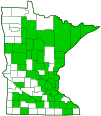Deer Mushroom
(Pluteus cervinus)
Conservation • Description • Habitat • Ecology • Distribution • Taxonomy
Conservation Status |
|
|||||||
| IUCN Red List | not listed |
|||||||
| NatureServe | NNR - Unranked |
|||||||
| Minnesota | not listed |
|||||||
Description |
||
Deer Mushroom is a medium-sized, nondescript, woodland mushroom. It occurs in Europe, Japan, southern Australia, the United States, Mexico, and southern Canada. In the United States it is common east of the Great Plains, uncommon on the West Coast, and mostly absent in between. It is common in Minnesota. It is found in the spring and again in the fall, alone or in groups, in deciduous and mixed forests and woodlands. It grows on decaying logs and tree stumps of hardwoods, occasionally also of conifers. It sometimes grows on the ground on underground tree roots or on soil high in lignin. It is similar in appearance to Patrician Deer Mushroom (Pluteus petasatus), a common wood chip species. Deer Mushroom will grow on sawdust and wood waste piles in woodlands but is not found on wood chips in urban areas. It gets its nutrients from decaying wood (saprobic). The cap is 1¾″ to 4″ (4.5 to 10 cm) in diameter. It is convex at first, flattening out and becoming broadly convex to flat when mature. Older caps sometimes have a raised knob or bump in the middle (umbonate). The upper surface is hairless, smooth, and dry, but slightly sticky when wet. It is dark or pale brown in the center and often paler toward the margins. The margin is straight and unlined or only faintly lined (striate). The stalk is 2″ to 5″ (5 to 13 cm) long and 3 ⁄16″ to ⅝″ (5 to 15 mm) thick. It may be straight or slightly broader at the base. It is usually covered with fine, grayish or brownish fibers (fibrils). Sometimes it is white and bald. The gills are broad, closely spaced or crowded, and not attached to the stalk (free). They are white at first, turning pinkish then eventually flesh-colored with age. Between the primary gills there are short, secondary gills originating at the margin. The flesh is soft and white. It does not change color when cut. It is edible. Young mushrooms are firm and have a radish-like odor and slightly radish-like taste. Mature mushrooms may be limp or waterlogged and not suitable for collecting. The spore print is pink. |
||
Similar Species |
||
Habitat and Hosts |
||
Deciduous and mixed forests and woodlands |
||
Ecology |
||
Season |
||
Spring and fall |
||
Distribution |
||||
|
Sources |
|||
| 7/25/2022 | ||||
Occurrence |
||||
Common |
||||
Taxonomy |
|||
| Kingdom | Fungi (Fungi) | ||
| Subkingdom | Dikarya | ||
| Phylum | Basidiomycota (Basidiomycete Fungi) | ||
| Subphylum | Agaricomycotina (Higher Basidiomycetes) | ||
| Class | Agaricomycetes (Mushrooms, Bracket Fungi, Puffballs, and Allies) | ||
| Subclass | Agaricomycetidae | ||
| Order | Agaricales (Common Gilled Mushrooms and Allies) | ||
| Suborder | Pluteineae | ||
| Family | Pluteaceae | ||
| Genus | Pluteus (deer mushrooms) | ||
| Section | Pluteus | ||
Recent research suggests that Pluteus cervinus is actually a group of closely related species that can be distinguished only by looking at the spores under a microscope. |
|||
Synonyms |
|||
Agaricus lividus Pluteus atricapillus |
|||
Common Names |
|||
Deer Mushroom Fawn Mushroom |
|||
Glossary
Saprobic
A term often used for saprotrophic fungi. Referring to fungi that obtain their nutrients from decayed organic matter.
Striate
Striped or grooved in parallel lines (striae).
Umbonate
On mushrooms, having a distinct, raised, knob-like projection in the center of the cap.
Visitor Photos |
|||||
Share your photo of this fungus. |
|||||
| This button not working for you? Simply email us at info@MinnesotaSeasons.com. Attach one or more photos and, if you like, a caption. |
|||||
Honey Fae (Farah) |
|||||
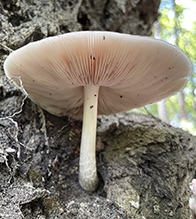 |
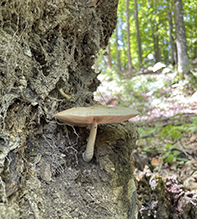 |
||||
Luciearl |
|||||
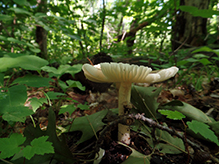 |
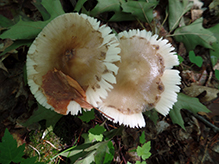 |
||||
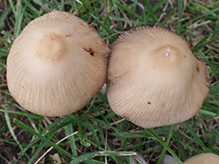 |
|||||
MinnesotaSeasons.com Photos |
|||||
|
|||||

Slideshows |
||

Visitor Videos |
|||
Share your video of this fungus. |
|||
| This button not working for you? Simply email us at info@MinnesotaSeasons.com. Attach a video, a YouTube link, or a cloud storage link. |
|||
Other Videos |
|||
| Deer Mushroom — Edible, But Is It Worth Eating? Learn Your Land |
|||
About
May 16, 2017 The Deer Mushroom (Pluteus cervinus) is an edible spring mushroom with mixed reviews. In this video, I take a look at this interesting fungus and discuss all facets of its existence. Music: Barefoot McCoy — Cali Follow Adam Haritan online here: |
|||
| Pluteus Cervinus mushrooms aka pink bottoms, deer mushroom, fawn mushroom MushFarmer |
|||
About
Aug 15, 2016 Pluteus cervinus is a mushroom commonly found on old sawdust piles around sawmills, etc. Also called deer mushrooms, fawn mushrooms, pink bottoms. Great to eat! |
|||


Created: 10/10/2020
Last Updated:
